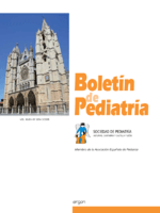Manejo y características de la bronquiolitis en niños ingresados menores de 3 meses en un hospital de tercer nivel
F. Álvarez Caro , J. Mayordomo Colunga , E. Valdés Vázquez , S. Jiménez Treviño , S. Suárez Saavedra , J. Rodríguez Suárez
Bol. Pediatr. 2008; 48 (205): 249 - 258
Objetivos: Describir la presentación clínica, parámetros analíticos, epidemiología, manejo terapéutico, así como la evolución respiratoria en los 3 meses posteriores, de los lactantes menores de 90 días, ingresados con diagnóstico de bronquiolitis durante el primer semestre del 2006 en el Hospital Universitario Central de Asturias. Material y métodos: Estudio epidemiológico, retrospectivo, realizado en el Departamento de Pediatría del Hospital Universitario Central de Asturias. Se revisaron las historias de los lactantes menores de 90 días ingresados con diagnóstico de bronquiolitis, entre el 1 de enero y 30 de junio de 2006, describiéndose parámetros clínicos, analíticos, epidemiológicos y terapéuticos. Resultados: En dicho periodo se atendieron 15.500 urgencias pediátricas, de las que 415 fueron bronquiolitis (2,6% del total), de ellos 88 eran lactantes de menos de 3 meses de edad (21,2% de la muestra). De todas las bronquiolitis ingresaron 129 (31% de la muestra), de estos ingresados 54 pacientes tenían menos de 90 días (61% de los lactantes menores a 3 meses, edad media de 47 días). La media de duración del ingreso fue de 8 ± 11,57 días (mediana: 8 días); la del score de Wood-Downes-Ferrés fue 4. El cultivo de exudado nasal fue positivo en el 50% para virus sincitial respiratorio (VSR), y el 7,4% para metapneumovirus. Se realizó radiografía torácica al 70,4%, siendo patológica en el 24,1%. El 20,4% presentaba tabaquismo pasivo, y el 35% antecedentes de atopia en familiares de primer grado. El 85,2% ingresó en planta de hospitalización, mientras que el 14,6% requirió ingreso en UCIP. En cuanto al tratamiento, hasta el 83,33% recibió adrenalina nebulizada, mientras que hasta el 38,9% recibió salbutamol nebulizado. El 14,8% ingresó en los 3 meses siguientes por proceso respiratorio. Comentarios: La bronquiolitis es una enfermedad potencialmente grave, tanto más cuanto más pequeña sea la edad del niño. Por esto, especialmente en este grupo etario, un porcentaje importante requiere ingreso en UCIP. El manejo terapéutico es un aspecto muy controvertido sin existir una indicación terapéutica de grado de evidencia A o B. En nuestra serie la adrenalina nebulizada es el fármaco más utilizado en los lactantes más pequeños.
Management and characteristics of bronchiolitis in children under three months of age admitted to a tertiary hospital
Objectives: Describing the clinic presentation, analytic parameters,
epidemiology and therapeutical management of infants younger than three
months, admitted at the Hospital Universitario Central de Asturias,
with the diagnosis of bronchiolitis during the first semester of 2006.
Material and methods: An epidemiological retrospective study, was
performed in the paediatrics department of the Hospital Universitario
Central de Asturias. Clinical records, from January, 1 to June, 30 of
infants younger than 3 months of age hospitalised with diagnosis of
bronchiolitis were reviewed, describing clinical, analytic,
epidemiologic and therapeutical parameters.
Results: In this period 15500 pediatric emergencies were attended,
being 415 of them bronchiolitis (2.6%), admitting to the hospital 129
(31%). 54 of them were less than 3 months of age (42%), over a total
amount of 88 infants who were attended less than that age (rate of
admission: 61%; mean age was 47 days). 64.8% were males. Median length
of admission was 6 days, and Wood-Downes-Ferrés´s score median was 4.
Respiratory syncytial virus (RSV) was isolated in 50% nasal culture,
and metapneumovirus in 7.4%. Chest x-ray was performed in 70.4%, being
pathological in 24.1%. In 20.4% first grade relatives smoked, and 35%
had personal records of atopy in first grade relatives. Eighty five
percent were admitted to the hospitalization floor; and 14.6% were
admitted at the intensive care unit. Focusing on medical therapy, 83.3%
of them received nebulized epinephrine, while 38.9% received nebulized
salbutamol. Nearly fifteen percent were admitted to the hospital in the
next three months because of a respiratory process.
Commentaries: Bronchiolitis is a potentially severe disease, in
relation with the child´s age. Because of its severity, especially in
this group of age, an important percentage requires admission to an
intensive care unit. Therapeutical management is still controversial,
as it does not exist a therapeutical indication with an A or B grade of
evidence. In our cohort nebulized epinephrine was the most used therapy
in the youngest infants.
Artículo completo (PDF) (119 kb.)
- Neumología
